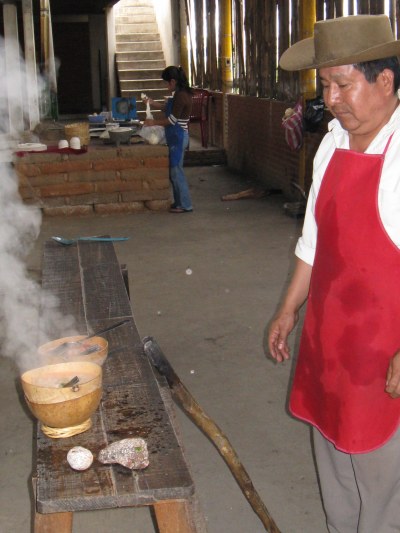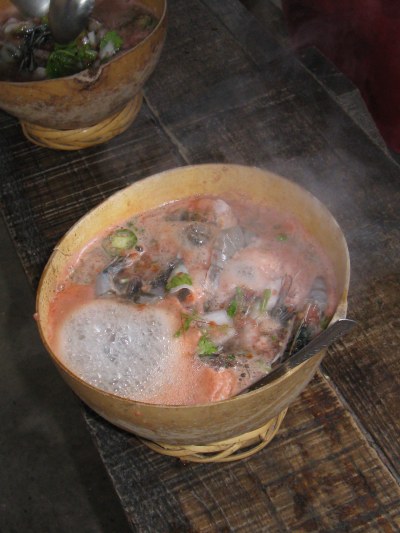 Campesinos working the land or tending flocks in the river valleys and hills of the Sierra Norte would stop, fish for trout, or perhaps gather lobster-like langostinos after the first rains in May, and then cook their bounty in an unusual way. They would place their catch in a half-gourd filled with river water and freshly picked aromatic herbs, heat rocks from the banks to red-hot, then place them in the bowl and watch their meal quickly poach in a boiling broth.
Campesinos working the land or tending flocks in the river valleys and hills of the Sierra Norte would stop, fish for trout, or perhaps gather lobster-like langostinos after the first rains in May, and then cook their bounty in an unusual way. They would place their catch in a half-gourd filled with river water and freshly picked aromatic herbs, heat rocks from the banks to red-hot, then place them in the bowl and watch their meal quickly poach in a boiling broth.
 Caldo de Piedra, located a few minutes outside of Oaxaca on the highway leading to Santa María el Tule, ceremoniously replicates the age-old custom before your eyes. The restaurant is a large, simple palapa with an open kitchen. The menu is effectively non-existent since all that is served are generously filled quesadillas and similar appetizers, your choice of three soups (the caldos), and non-alcoholic beverages.
Caldo de Piedra, located a few minutes outside of Oaxaca on the highway leading to Santa María el Tule, ceremoniously replicates the age-old custom before your eyes. The restaurant is a large, simple palapa with an open kitchen. The menu is effectively non-existent since all that is served are generously filled quesadillas and similar appetizers, your choice of three soups (the caldos), and non-alcoholic beverages.
 The owners boast that this traditional meal preparation dates to pre-Hispanic times, and was practiced in their home village, San Felipe Usila, in the district of Tuxtepec.
The owners boast that this traditional meal preparation dates to pre-Hispanic times, and was practiced in their home village, San Felipe Usila, in the district of Tuxtepec.
 Service is uncharacteristically fast. Waitresses are eager to attend to orders, and more importantly answer all queries about your comida’s preparation, so be sure to ask to go over to the two kitchen areas to bear witness to the procedural pomp. On the one side are women working over metate (grinding stone) and comal (large round clay “stove-top” used for cooking over an open flame), hand-making tortillas for filling with your choice of quesillo (the famed Oaxacan string cheese), mushrooms, squash blossoms and more. On the other side unfolds the curious convention. A substantial helping of your choice of raw, medium sized shrimp, red snapper, or a combination of the two is placed in a jícara (the half gourd) with a selection of chiles, onion and leafy herbs including requisite cilantro. A blender off to the side is used to prepare a tomato-based liquid which is then poured into each vessel. With the aid of a large wooden tong, a couple of baseball sized river stones are plucked from a flaming fire pit, gingerly placed in each gourd, and voilá, your meal starts to boil. Rocks are added a second time, following which each comida-in-a-pot is brought to the table.
Service is uncharacteristically fast. Waitresses are eager to attend to orders, and more importantly answer all queries about your comida’s preparation, so be sure to ask to go over to the two kitchen areas to bear witness to the procedural pomp. On the one side are women working over metate (grinding stone) and comal (large round clay “stove-top” used for cooking over an open flame), hand-making tortillas for filling with your choice of quesillo (the famed Oaxacan string cheese), mushrooms, squash blossoms and more. On the other side unfolds the curious convention. A substantial helping of your choice of raw, medium sized shrimp, red snapper, or a combination of the two is placed in a jícara (the half gourd) with a selection of chiles, onion and leafy herbs including requisite cilantro. A blender off to the side is used to prepare a tomato-based liquid which is then poured into each vessel. With the aid of a large wooden tong, a couple of baseball sized river stones are plucked from a flaming fire pit, gingerly placed in each gourd, and voilá, your meal starts to boil. Rocks are added a second time, following which each comida-in-a-pot is brought to the table.
| |

|


